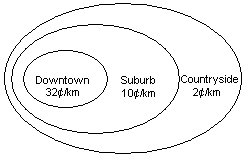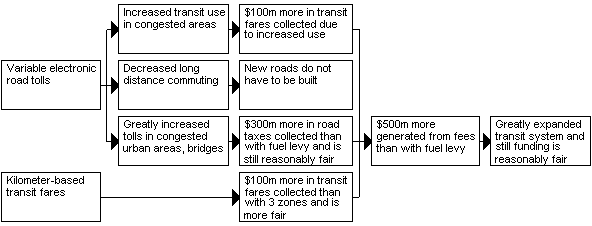|
Fig 14 Travel Management solutions to urban travel problems
Modern travel planning should be based on stick-user fee-carrot travel management techniques. Apply a little pressure to reduce the long distance rush hour motor vehicle commuters (stick) while at the same time supplying a transit system that is faster than the motor vehicle (carrot) or lower fees in countryside areas (carrot).
26. ELECTRONIC ROAD TOLLING
A future travel management solution that would have the greatest effect on reshaping traffic while at the same time being most fair to all the groups involved would be electronic tolling of motor vehicles where charges vary with time of day, route, region, vehicle weight, and total kilometers driven. While this may sound like a science fiction solution, in reality several cities around the world have already implemented such a system. To be effective, such tolling would need to be applied province wide. In such a system, motorists driving in really low density regions would pay perhaps 2 cents/km, compared to motorist's driving through the city center during rush hour who would be charged 30 cents/km. Driving on major bridges and busy highways during rush hour might cost 10 cents/km. These prices represent a tolling system were fuel taxes were completely removed, which might not be desirable. While long distance urban commuters might be angry at paying up to $10/day in road tolls, they are the one's that are using the busy congested roads. Another long distance commuter living and working in the countryside might only pay $2.00/day to commute the same distance.

Fig 15 Zones used for electronic province-wide tolling and possible costs for rush hour travel
If electronic tolling were applied province wide, there would be no urban border issues such as we now face in the GVRD. Presently an urban commuter living outside of the fuel transit levy area can totally avoid paying transit levies if they purchase fuel where they live. They are however big users of the roads. This is why it also doesn't make sense to apply motor vehicle tolling to only motor vehicles registered inside the GVRD.
Electronic tolling may seem a drastic measure to motorists, however there is no other technique that would be as fair at applying motor vehicle charges. While many motorists can see the logic of such tolls, they fear that politicians would use such measures as a cash cow and become inefficient.
Presently there are also major inequalities of transit fares in the GVRD. The entire GVRD is divided into three transit zones. If someone is taking transit 1 km down the street they presently pay $1.75. If another person travels 25 km in a single zone they also pay only $1.75. Someone living on the edge of two zones however would need to pay $2.25 to travel just 1 km if they crossed a zone border. Such zones don't make for a very fair pricing structure. New electronic methods of collecting transit fares by the kilometer appear to be possible. Transit users would carry pre-paid cards which contained a tiny microchip that would be activated only while they were on a bus. Trip fees would be subtracted from the original amount on the card. Though many people would pay less for short trips, it might be possible to collect about 1.5 times as much money as is presently due to slightly higher charges for longer trips and more people taking transit for shorter trips.
Road tolling however does not deal completely with the issue of people in the congested parts of the city not contributing to transit subsidies. Unfortunately there is only one completely user-pay system to solve this and that would be to raise transit fees to cover the complete cost of transit. No form of tax in the congested parts of the city would be entirely fair. This is because there are many people living in these areas that don't use transit or drive motor vehicles, they rather walk or bicycle. Electronic road and transit tolling does however make possible two things that start to make transit subsidies fair. First, somewhat higher transit fees are possible because motorists have to pay stiff charges in congested areas. Second, higher road fees pressure more people to take transit. This generally makes transit more cost effective and in turn needs less subsidies. Coupled with the higher amount of money that could be collected with electronic transit fares, the transit system would need less subsidy or may not even require a subsidy in the future. Most people would not object to such a system because it would be closer to a user-pay system. This is illustrated in the logic flowchart in Fig 16.
Of course electronic road tolling has numerous difficulties that would need to be sorted out. For example, what can be done with out-of-province visitors? How easy is it to tamper with the units, how expensive are they, and are they reliable? Would people consider them to be an invasion of privacy. In spite of these difficulties, electronic tolling does appear to be feasible.

Fig 16 Logic flowchart showing benefits of future electronic road and transit tolling
27. CONCLUSIONS
The general plan in the Greater Vancouver Regional District of primarily expanding the rapid transit system rather than adding new road lanes is good. Though transit does not work well in a wide variety of situations, it is presently our only hope in the higher density parts of the GVRD to reduce motor vehicle congestion especially during rush hour and maintain a livable region. As well, future fuel prices may make transit more and more desirable for people in urban areas.
It would be better to have money for transit, ferries, and roads in the province come directly from provincial coffers as shown in Fig 17. This means that no single group is unfairly hit in a big way for the transit subsidy. Using money from the provincial government has the advantage of drawing from different sources as time goes by as shown in the different scenarios of Fig 17 without having to change legislation every time a new source of funding is to be used or disappears.

Fig 17 Money for transportation should come from Provincial government coffers
Logically flat rate motor vehicle fees make little sense because almost every transportation study that has ever been done points to the benefit of reducing flat rate motor vehicle fees and rather introducing mileage based fees. In the future motor vehicle fees would be applied more fairly to all the different regions if variable province-wide electronic road tolling could be implemented. Mileage based transit fares should also be implemented. Transit subsidies indexed to motor vehicle fuel use or mileage however don't make sense because when people drive less and use transit more, there is less money collected to fund transit. So motor vehicle fees should be mileage based but the transit subsidy should be based on the number of people in a certain region and the specific projects that should be developed.
It appears that total motor vehicle taxes and fees in the GVRD already represent up to 200% of the cost of present road construction and maintenance. On the other hand transit users are paying roughly 25% of total transit costs. A reasonable argument can be made for using these motor vehicle tax surpluses to partially offset transit subsidies. There is already enough money collected within the GVRD transportation system to fund the entire road and transit system with no additional fees.
Unfortunately the funding agreement that was negotiated between the province and TransLink was not adequate. It was based on the old subsidies to the GVRD transit system. The previous subsidy money was based on only operating costs of buses and rapid transit vehicles. TransLink however is supposed to be responsible financially for most roads, buses, rapid transit vehicles, and rapid transit trackways. The cost of these extra's is far beyond what the old subsidy included. So TransLink wants to get the extra money from motor vehicle owners. Realistically the money should come from that already collected. The whole TransLink organization and funding structure should be revised.
.
Buses running on regular public roads do not provide a very effective means of public transit. They are generally slower than the already slow motor vehicle traffic. They are expensive to operate due to the manpower required. Rapid transit is much more appealing to average commuters especially for long trips because of the speed and comfort. This type of transit should be promoted. It is expensive presently because systems are nearly custom made. Less expensive forms of rapid transit should be developed.
Motor vehicles will always be very desirable for many types of trips. Improvements should continue to be made with efficiency and emissions. The value of land in urban areas is very high. Advanced technology should be used to make major roadways more efficient.
28. NOTES
[1] TransLINK Strategic Transportation Plan 2000Apr p5
[2] TransLINK Strategic Transportation Plan Appendixes 2000Apr p7
[3] TransLINK Future Search p5
[4] TransLINK Strategic Transportation Plan Appendixes 2000Apr p9
[5] Most of the known revenues and expenses were obtained from TransLINK Strategic Transportation Plan Appendixes 2000Apr p26. Capital costs however were generally averaged and interest was not considered. It seems reasonable to not consider interest on capital items in public organizations especially if the funding comes largely from the Provincial government. The great mix of different capital intensive programs could be considered to result in even yearly capital expenditures.
29. REFERENCES
BC Transit, 2000Feb26 History, Funding, Partnerships, www.bctransit.com
BC Transit, 1996Oct10 BC Transit Five Year Plan and Funding Strategy, www.city.vancouver.bc.ca
California Transit Association, 1992 California Transit...Funding Crisis, www.transitassociation.org
GVTA, 1998Feb5 Transportation, Governance and Funding Consultation Report, www.gvrd.bc.ca
GVTA, 1997May Recommended Agreement on Transportation Governance and Funding for Greater Vancouver, www.translink.bc.ca
Hage, Eva, 1998Jan05 Review of Transportation Costs and Revenues to be assumed by the Greater Vancouver Transportation Authority, www.translink.bc.ca
Litman, Todd, 2000May31 Shifting Gears, Transportation Demand Management in the Vancouver Region, www.vtpi.org
Litman, Todd, 2000May31 TDM Encyclopedia, www.vtpi.org
Litman, Todd, 1999Dec02 Evaluating Public Transit Benefits and Costs, www.vtpi.org
Love, Jean/Cos, Wendell, 1991Oct17False Dreams and Broken Promises, www.cato.org
GVTA, 1999Jul12 Greater Vancouver Transportation Authority Act Chapter 30, www.translink.bc.ca
Price, Gordon, 1999Dec A Local Politicians Guide To Urban Transportation, www.vtpi.org
Province of BC, 1998Oct01 Motor Fuel Tax Act, www.gov.bc.ca
Taxi2000, 2000 Taxi2000 System Overview, www.taxi2000.com
The Province, 2000Jul20 Gas Tax Revolt
TransLink, 2000Apr TransLink Strategic Transportation Plan 2000-2005, www.translink.bc.ca
TransLink, 2000Apr TransLink Strategic Transportation Plan 2000-2005 Appendixes , www.translink.bc.ca
TransLink, 1999Sep18 Future Search, www.translink.bc.ca
TransLink, 1999 TransLink Budget, www.translink.bc.ca
TransLink, 2000May TransLink and The Major Road Network, TransLink flyer
Weyrich, Paul M./Lind, William S., 1999May Does Transit Work, www.apta.com
30. REVISION HISTORY
2000Aug30 First draft copy, 17 pages, 17 illustrations
2000Sep21 Second draft copy, 17 pages, 17 illustrations. Changed about 25% of text and corrected small errors.
2000Oct11 Final copy, corrected small errors.
2001Mar24 Major changes to beginning and end sections.
COPYRIGHT © 1999-2023 All rights reserved
Ben Wiens Energy Science Inc. Metro Vancouver BC Canada
|

